Even though he has managed to secure Europe for his team, Javier Calleja has been fired as the coach of Villarreal. It was a decision that perplexed many, given the stellar post-lockdown form and stability the Yellow Submarine has found, but it’s also one that shows great ambition. Unai Emery was chosen as Calleja’s successor and will assume the mantle of their new coach for the 2020/21 season, as was now officially confirmed.
Check out Betting.net for value bet options.The former Arsenal man has quite a resume despite a mixed tenure in London. His stints with both Sevilla and Paris Saint-Germain, however, have been crowned with silverware and good tactical nuances, especially in the case of the former team at which Emery accomplished admirable European success, clinching three Europa League titles in a row.
This, on its own, makes him the man to hire if you’re on a lookout for titles outside the domestic scene. One can’t expect Villarreal to suddenly challenge Barcelona and Real Madrid’s duopoly over La Liga but Emery’s tactics seem to work best when he’s coaching a mid-to-top tier team or an underdog altogether. Both his tenures in Spain – with Valencia and Sevilla – and even his stay at the Emirates to an extent, are the clearest examples of that.
But what exactly can Emery bring to Villarreal and how do his tactics translate to the Yellow Submarine and the technical football in La Liga? This tactical analysis will try and answer those very questions and tell you what we can expect from this side in 2020/21.
Let’s dive straight in.
Build-up play
Emery is certainly renowned for his high emphasis on positional play, a rigid structure within the systems used and preferring an attacking philosophy over a sturdy and reliable defence. This part of our tactical analysis will study his approach to the build-up play and how his tactics from Paris Saint-Germain and Arsenal – and even beyond that – could potentially translate to Villarreal.
The 48-year-old coach loves possession-based football and is a big advocate of a structured build-up from the back. You could even say that he lives and dies by that philosophy, as we’ve seen him experience both sides of the coin while at Arsenal. Still, while during his time with Valencia and Sevilla he favoured a more direct approach at times, Villarreal are a team that’s slowly but surely leaning towards a purely positional system.
Calleja has had some trouble with establishing a clear-cut identity at the club when he was re-appointed the head coach but this problem was mostly fixed by the time the second part of the campaign arrived. This is also why many couldn’t understand his sacking. The timing of it was odd, to say the least, especially since he had just secured them European football.
Below, you can see a graphic we at TotalFootballAnalysis use to describe a team’s style of play. This one, in particular, shows us Villarreal’s attacking approach. According to the data, they are a team who favours positional play as opposed to a direct one and will build their attacks with short passes, mainly through the centre. Finally, once they reach the danger areas, they will resort to shooting quite often.
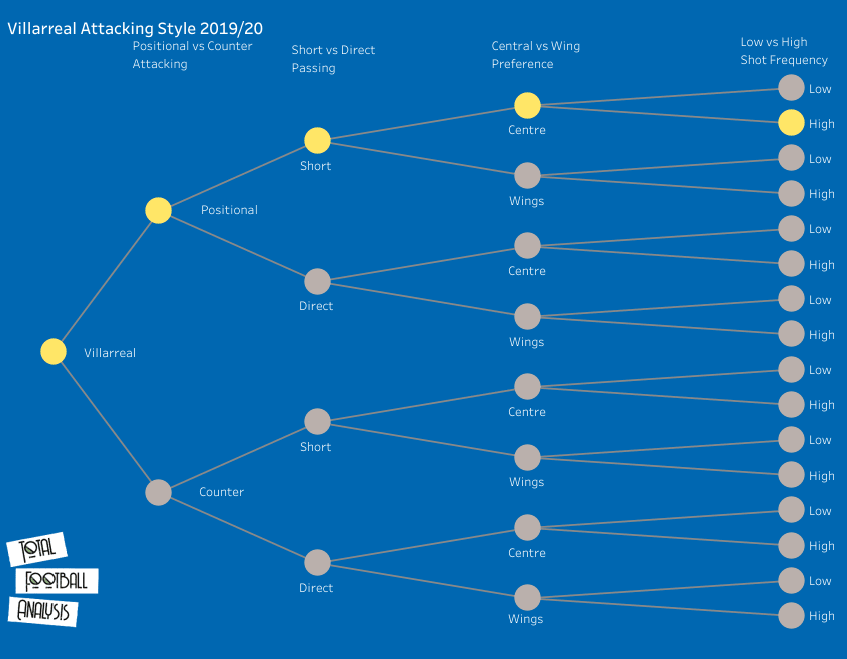
Judging by this first glimpse of Villarreal’s current philosophy, Emery could indeed be a great fit. He too favours the positional approach and tends to combine through short passes. However, his teams are generally focused on the wider areas where they can advance the ball and then send passes into the box.
Generally speaking, the Spaniard prefers the 4-2-3-1 formation, which he used at both Sevilla and Arsenal, but is also not afraid to change things up, also utilising a 4-3-3 that could also look like a 4-1-2-2-1 system as well. This has been both a strength and a weakness of his since he is quite adaptable and will tailor his system to the opposition. But at the same time, he was often criticised for not having a set structure nor a gala XI in place.
There are, however, two ways Emery’s sides approach the first phase of build-up play: A single pivot dropping deeper – like Thiago Motta used to do at PSG – or a double pivot helping the centre-back duo bypass the first line of press – as was the case at Arsenal with Granit Xhaka and Lucas Torreira or Mattéo Guendouzi. Let’s explore the first case a bit more below.
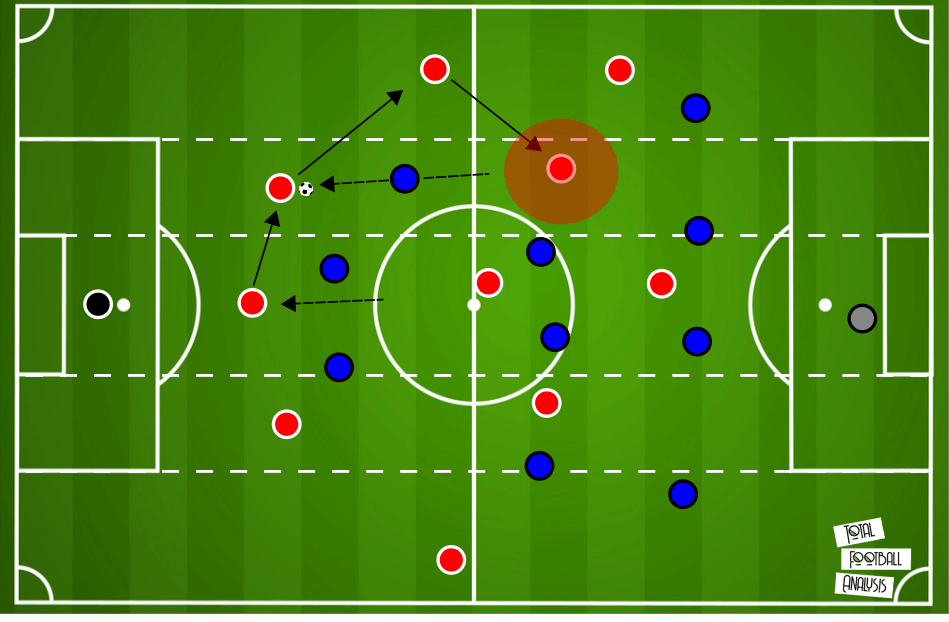
The graph above depicts a fairly common approach when using a single pivot who’s positioned between the centre-backs. This is mostly done so that the defensive line has a numerical superiority over the opposition’s first line of press. It also means the defending team has to decide whether to push an additional midfielder into the first line to battle the inferiority or risk allowing the ball progression to occur much smoother for the attackers.
But even if they do decide to level the playing field by moving an additional player higher up, this means that the space opens up in other areas, paving the way towards the full-back or the centre, as the graph above depicts.
Here’s an in-game example showing exactly that as Xhaka is the one to form a back three against Fulham. Notice how the formation of the pressing squad shifts to a three-man line and then also starts a chain reaction of movement.
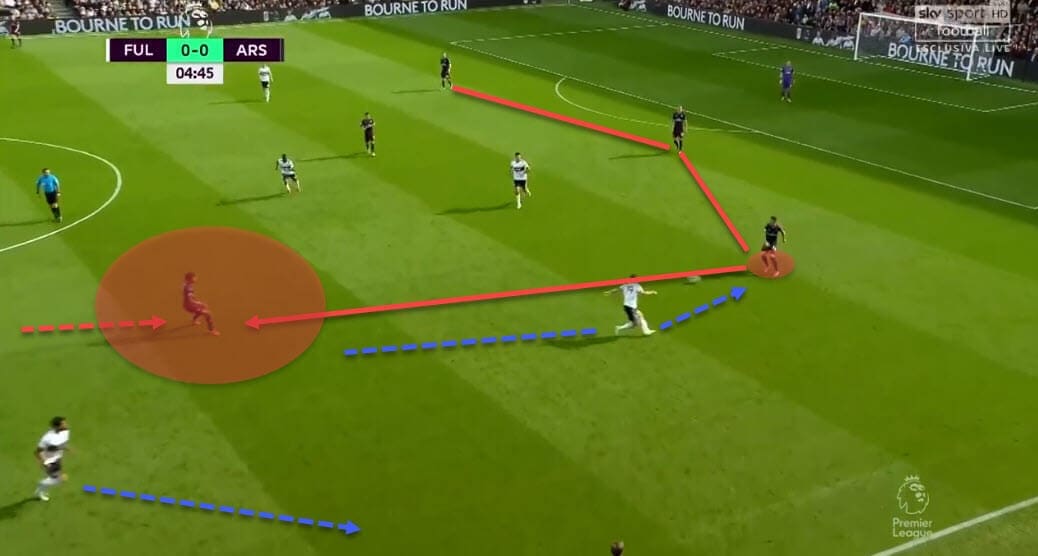
Since a man from the second line has jumped on the ball-carrier, the opposition’s full-back has to jump on Arsenal’s wide man. But that also means that Alex Iwobi who’s dropping from the advanced area is not marked and can receive the pass freely. In that way, the Gunners advance play successfully.
In the case of a double pivot build-up, Emery alternated his tactics depending on the press of the opposition. Sometimes, one midfielder would drop while the other stayed higher if that was enough to move the ball forward. However, most of the time, and especially against teams that were good at pressing, he would drop both pivots deeper to help the centre-backs progress.
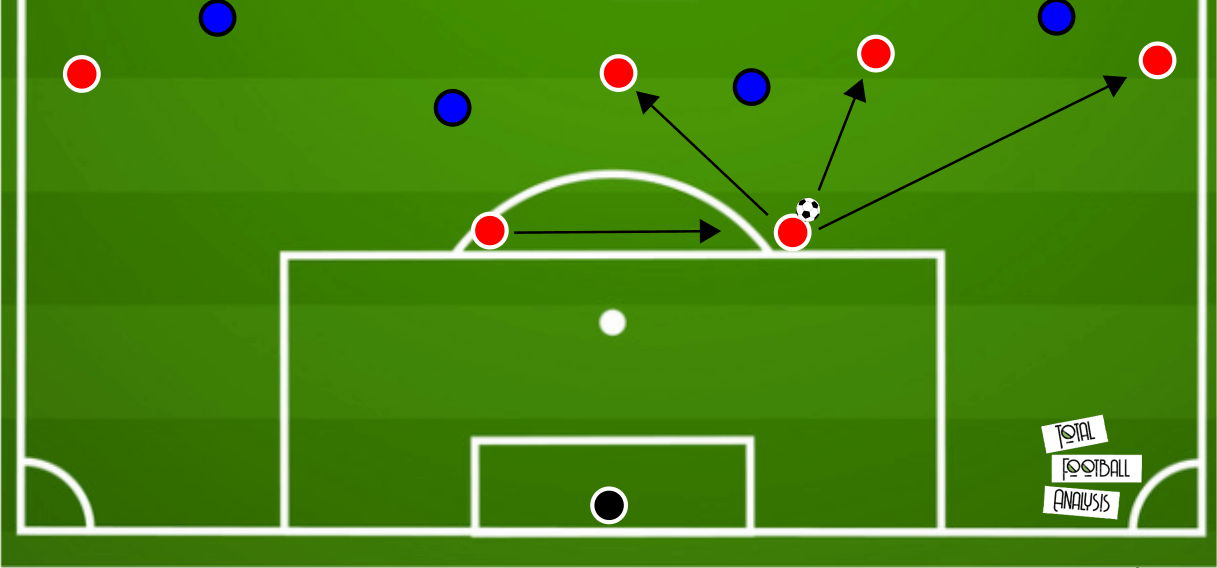
The above graphic is a simple representation of that structure. The full-backs are higher and the pivot drop closer to the backline. That way, as they form a four-man line with the wide players, they create a decisional crisis for the opposition and ensure the ball can be played forward from the centre-backs.
Let’s observe one in-game example against Manchester United below. The Red Devils are pressing with a two-man frontline so Emery has both of his pivots drop. Notice how there are multiple channels to progress the play and United’s players have a decisional crisis to solve as the right-back drops to support too.
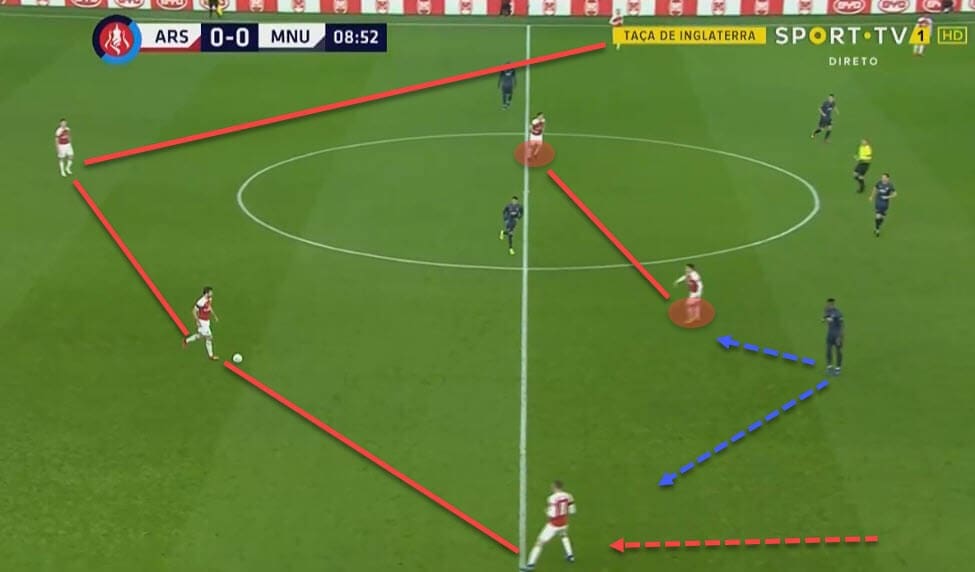
And looking at Villarreal’s personnel specifically, it’s likely Emery opts for the latter option. It lines up perfectly with his 4-2-3-1 formation and seeing how the Spaniards also often use a double-pivot system in either a 4-4-2 (32%) or a 4-2-3-1 (8%), this is likely the way to go.
Vicente Iborra and Zambo Anguissa can be used in those respective roles and would offer their coach enough in terms of progression and stability on the ball. Of course, one huge thing to note is that Emery won’t have the magic of Santi Cazorla at his disposal while Bruno Soriano and Anguissa won’t be available too, with the latter returning back to Fulham following the end of his loan spell. Iborra can be an advanced player too but both were capable of slotting into the hole to great effect.
But there are players like Manu Trigueros and Manu Morlanes who have been used there as well, even though the latter is also an attacking midfielder by trade. So it’s likely we see Emery use this kind of system to support the positional style he’s bound to implement at Villarreal. Below, we can see Anguissa and Soriano drop to assist the build-up that starts from the goalkeeper, beating Eibar’s press easily.
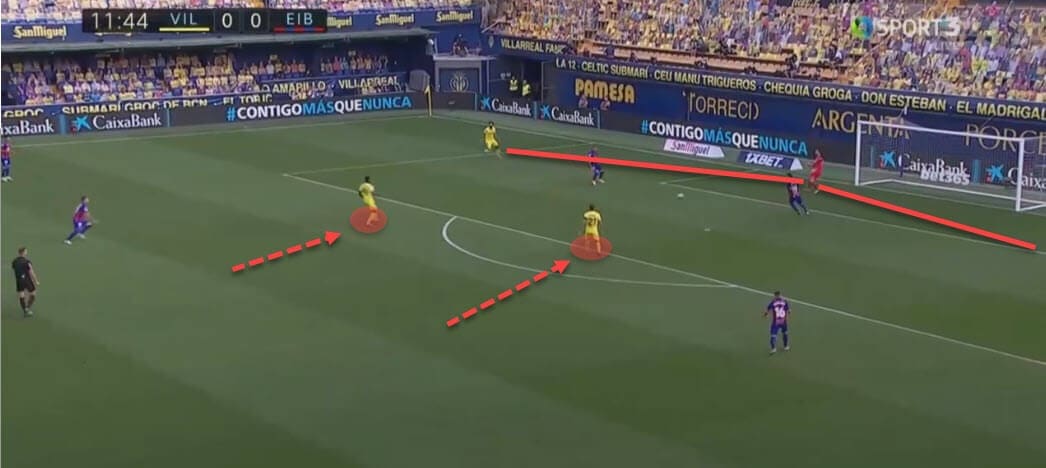
Anguissa receives the ball and proceeds to shrug off the opposition’s midfielder and advance up the pitch. This is an incredible asset to have for Emery and he will undoubtedly love to use it. Villarreal’s pivots tend to be staggered too and if only one is needed to progress the ball, only one will drop while the other stays higher.
Occasionally, one can also position himself in the backline to help spread the pitch and stretch the opposition’s pressing squad. In those cases, it’s not unusual to see an additional player drop from a higher line to assist if the progression has been halted. We would often see Cazorla in that role but Emery will have to give that task to a different player now.
But of course, for all of that to work, good ball-playing centre-backs are an absolute necessity. We’ve seen that the majority of Emery’s issues at Arsenal stemmed from inadequate personnel in the backline, which was later on improved with Bernd Leno and David Luiz. So how do Villarreal’s defenders measure up to the rest of the La Liga players in terms of ball progression?
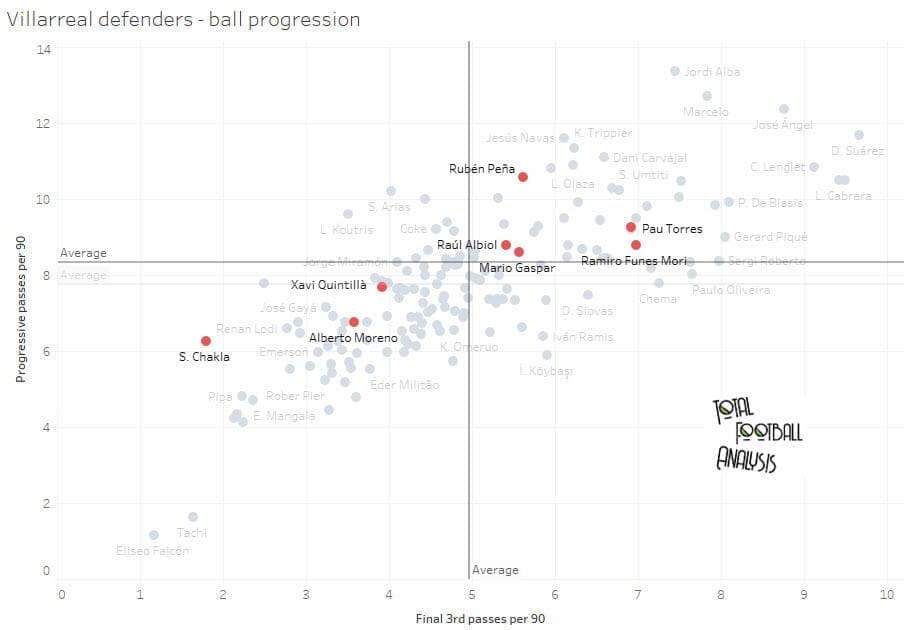
Pau Torres is a young centre-back on the rise who is reportedly being tracked by multiple big clubs. He seems like an excellent ball-playing defender who will undoubtedly play a major part in Emery’s tactics, if he can retain him that is. But while Ramiro Funes Mori seems great here as well, his lack of game time has unfortunately skewed the data findings.
Torres’ likely partner in crime will therefore be Raúl Albiol, as was the case for the majority of the 2019/20 season, and he too seems pretty comfortable on the ball and ranks above-average in both progressive passes per 90 and final third passes per 90 among other La Liga defenders.
So far so good for Mr Emery.
Final third tactics
Now that we have covered Unai Emery’s tactics in the first phase of build-up, this analysis will shift towards the higher areas of the pitch and deal with his approach in the final third. There are a couple of key concepts the Spaniard loves to utilise and most of them have been presented in every team he has coached so far. This leads us to believe he will indeed stay true to his philosophy at Villarreal as well.
Wthout a shadow of a doubt, full-backs have always played a huge role in the attacking phase of Emery’s teams. This goes hand in hand with the build-up tactics as it’s usually the centre-back duo working together with the pivot(s) to progress the ball. And while the full-backs can and will drop when and if necessary, they are generally operating much higher up the pitch, essentially as wing-backs at all times.
So even though the team may start a game in a 4-2-3-1 or a 4-3-3, that often transforms into a 3-4-3 or even 4-2-2-2/ 2-4-2-2 once the full-backs start pushing forward and the pivot(s) move accordingly. Below, you can see a graph that depicts some of the general movement we can expect to see.
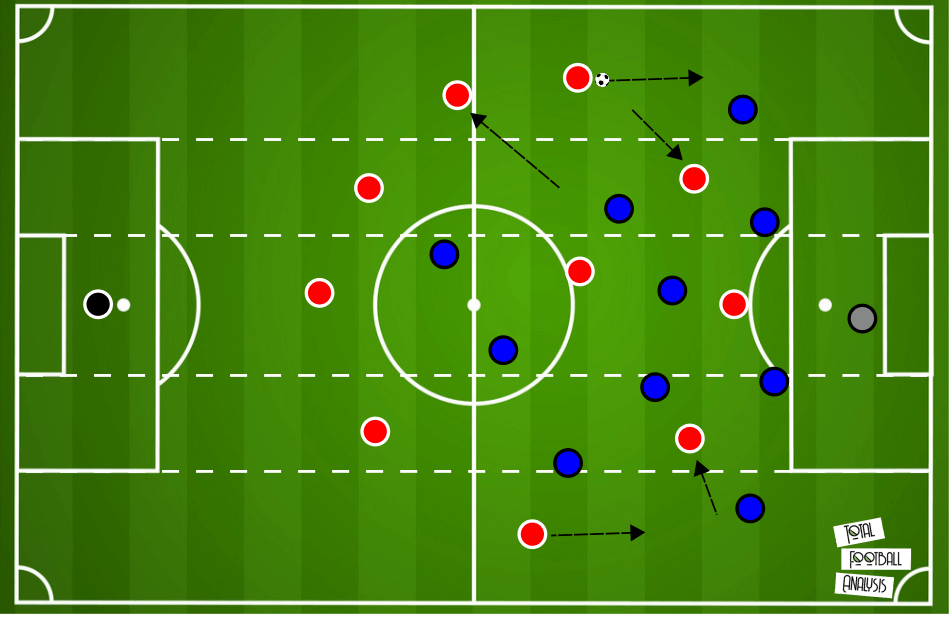
The pivot has dropped in-between the centre-backs to make a back three and this has urged the full-backs to drive forward. The back three offers solidity and spread for the backline so that the team is not undone on the counter as the wide players leave lots of space behind their backs.
But Emery will sometimes instruct one of the midfielders to drift wide for cover just in case. This formation can also become a 2-4-2-2 if the double pivot remains in place and the build-up is achieved solely through the centre-backs. But this also works better when there are two strikers up front, which is what Emery did have in Alexandre Lacazette and Pierre-Emerick Aubameyang.
This setup with the high emphasis on the full-backs also means the 48-year-old coach loves to construct play through the wings while Villarreal, as we’ve seen from the initial attacking style of play graph, are a predominantly central team even though it might not seem so at first. Another thing we have to note and is also visible from the graph is the positioning on the forwards.
In case there is a single striker, he will be used as a focal point who can hold up the ball and become a presence in the box. An example would be the way Emery used Edinson Cavani at PSG. Sometimes, the player would drop to link-up with the midfield but his predominant role was higher up the pitch. Still, the emphasis is very much on the half-spaces and those are reserved for the inverted wingers or inside forwards.
That way, once the full-back has successfully overlapped, Emery can overload the opposition’s wide defender and send his player into space to deploy low crosses and cut-backs. Notice such an example in the graph below.
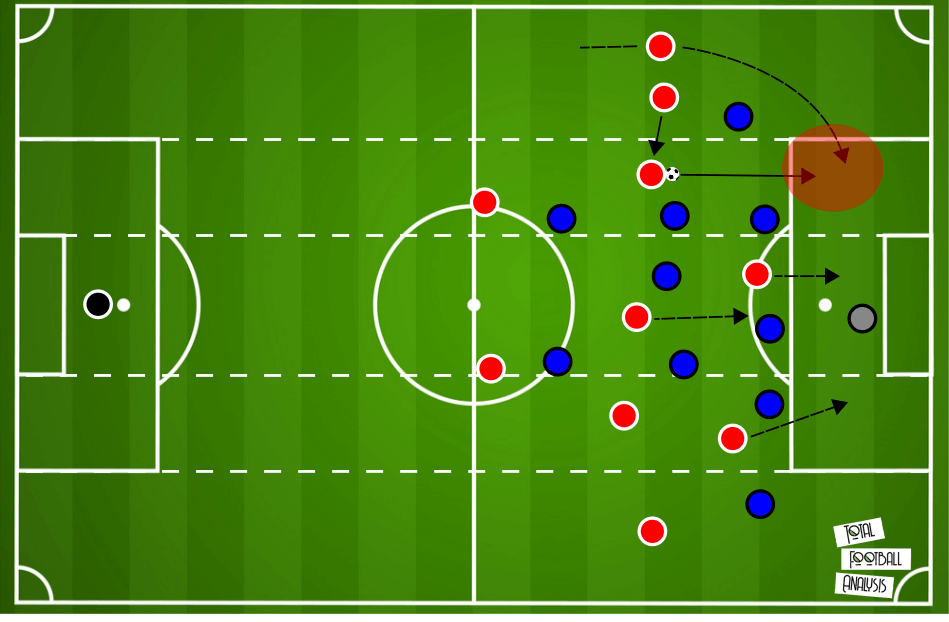
Another thing to observe above is how the rest of the players then swarm the box and try to get on the end of that pass from the full-back. This is a common tactic Emery uses and it’s the kind of approach we could potentially expect at Villarreal. In this particular situation, Arsenal have at least a 2v1 scenario out wide that potentially turns into a 3v2 once the midfielder and his marker join the action.
Here’s a similar example, only this time we’re using an in-game image to demonstrate it. The full-back is wide and high and on the ball while the winger tucks inside into the half-space. One of the strikers will also drift wide and make a run, a feature we will often see at Villarreal as well, to complete the 3v2 overload on the left.
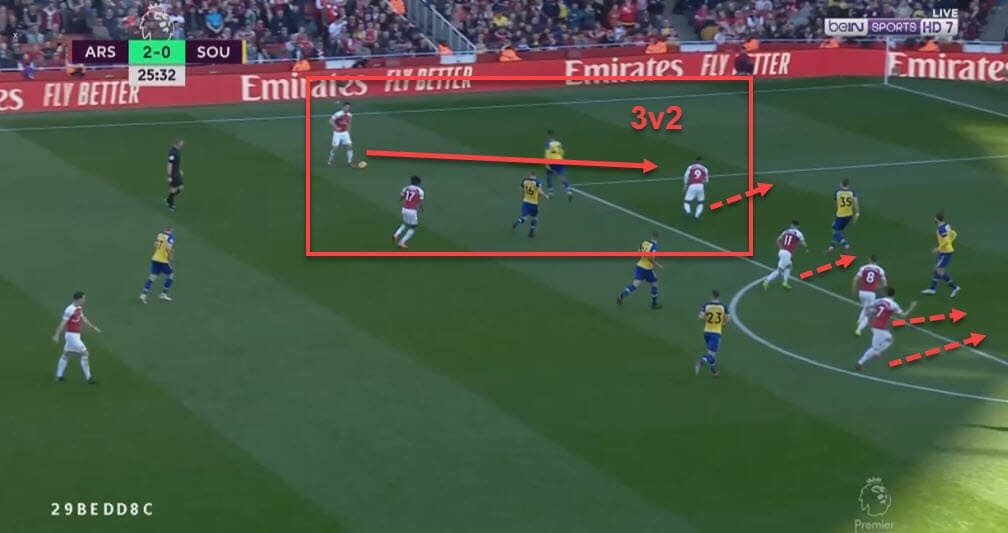
Another thing to notice is once again how Arsenal send everyone into the box as soon as there’s a chance of a pass to be deployed from the wider areas.
This, however, now begs the question of whether Villarreal have the personnel to carry these tactics out. If Emery plans to put a huge emphasis on the full-backs once again, which he will most likely do, they will have to be comfortable with following those structures.
Before we see them in action, let’s first compare them to the rest of La Liga’s full-backs in terms of creativity in the final third. Of course, there are multiple metrics that we can use to do that but since Emery’s teams tend to send low-crosses and cut-backs into the box or to the edge of the box, we’ll use deep completions and deep-completed crosses as our examples. Both are passes that are targeted to the zone within 20 meters of the opponent’s goal so they fit our criteria.
And to see how dangerous those passes are, we’ve also added the expected assist (xA) per 90 value, which is represented by the size of the dot in the graph.
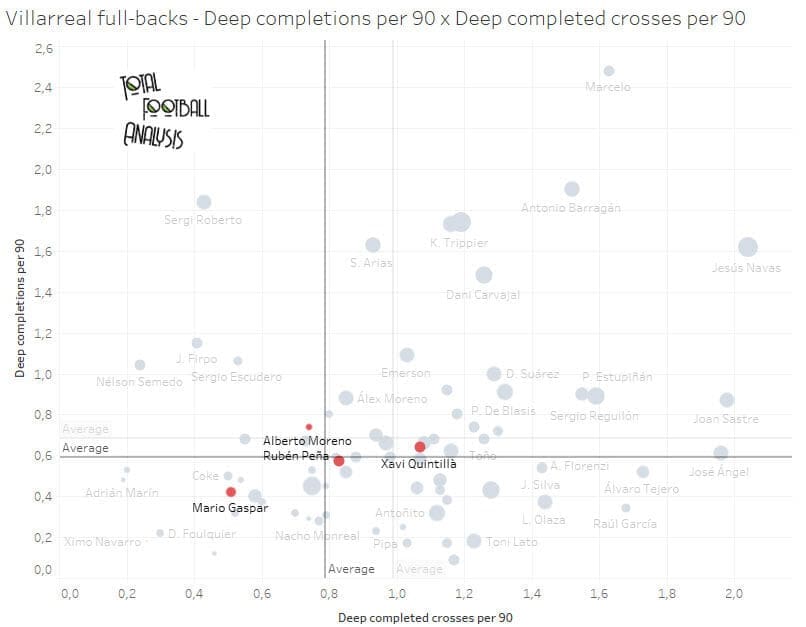
The left-back Xavi Quintillà seems to be Villarreal’s most dangerous full-back and is then followed by his counterpart Rubén Peña on the other side of the pitch. Both players are decent in the metrics analysed with the former being above-average in both and the latter in deep completed crosses.
Overall, this is an encouraging sign because both have good xA values as well and should be players Emery can work with. Alberto Moreno and Mario Gaspar, however, don’t seem to offer that kind of output and it will be interesting to see what combinations the coach goes for.
In general, the Yellow Submarine does highly prefer the left side of the pitch when attacking and deploying crosses, and they are only 14th in crossing frequency in La Liga but fifth in accuracy with 33.9%. But that’s nowhere near their biggest weapon in attack. Quick transitions and open-play creation, however, certainly are.
Assuming Emery will want to use a single striker flanked by two wide players, Samu Chukwueze, Moi Gómez, Javi Ontiveros or even Peña can serve the role of inverted wingers quite well. Even though Villarreal like to hold their width, we have seen them operate in a similar manner before. The wingers tuck into the half-space, the centre-forward stays up front and the full-backs get the space to either drive into or send a penetrative pass. But their movement doesn’t have to be so strict.
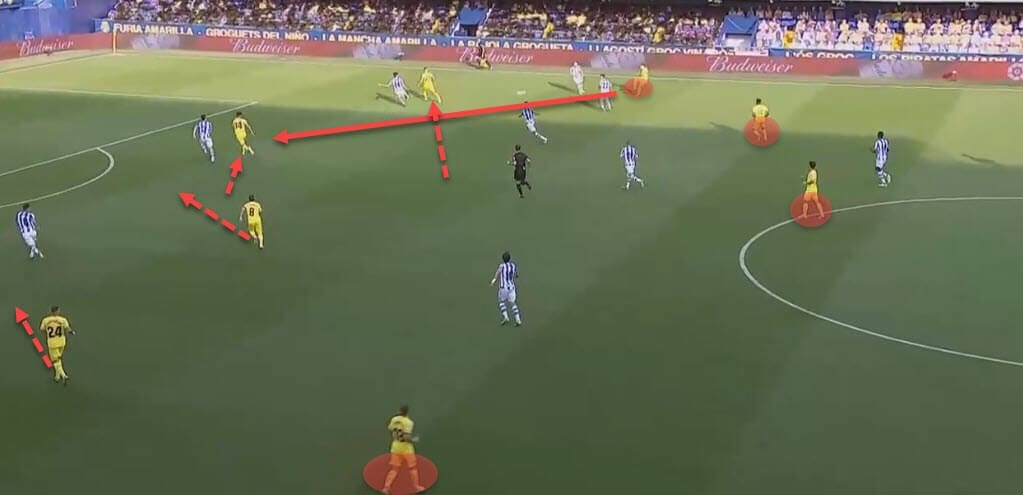
Above, it’s actually the striker, Fernando Niño, who drifts towards the half-space after Gómez has dragged the marker wide, opening a channel for Peña to exploit. Cazorla, the attacking midfielder, takes a central position while Ontiveros occupies the half-space on the other side. The whole sequence was done beautifully and Real Sociedad couldn’t defend against it.
And you remember how we talked about midfielders drifting behind the full-backs for additional cover? The same thing happens above as the circled players (apart from the player sending the ball) are there to provide rest defence in case of a turnover.
Another aspect that will please Emery is the fact Villarreal are a team that love to switch sides during attack, often inviting the pressure on one flank only to quickly swap the action to the other. This is how they consistently ensure overloads can be achieved. Often, it will be the striker who’s flexible enough to drift, drop or stay central depending on the situation. Below, for example, it’s Gerard Moreno who takes the initiative and creates an overload on the left.
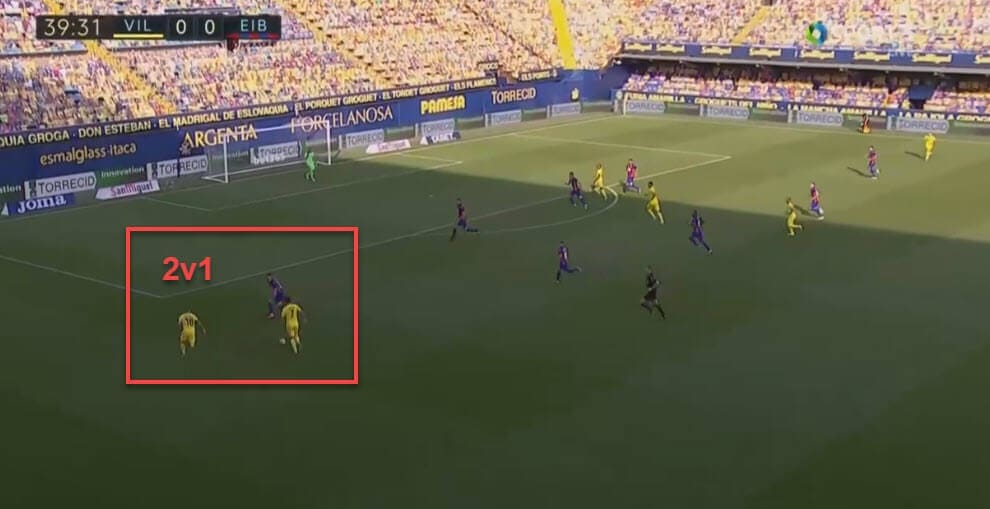
This is not unlike Lacazette or Aubameyang who tended to do the very same thing for Emery during his stay at Arsenal. And before them, Cavani was occasionally used as a link-up man, albeit in a more central role. But with a creative presence who can slot in the no.10 position, such as Neymar Júnior at PSG or Mesut Özil at Arsenal, Emery would also deploy a dual-striker partnership to great effect.
And indeed Lacazette and Aubameyang are the perfect examples of how that can work productively. One would often be tasked to stay higher and be less flexible while the other has more freedom to move around the final third. This is definitely an avenue Emery can explore at Villarreal.
The only thing he has to decide is who to use as Moreno’s partner. The possibilities, however, are more than just decent: Paco Alcácer, Chukwueze, Carlos Bacca, Niño and even Iborra can fill in the gaps and perform well. The bigger question, however, is who will replace Cazorla in that creative role just behind the striker(s)?
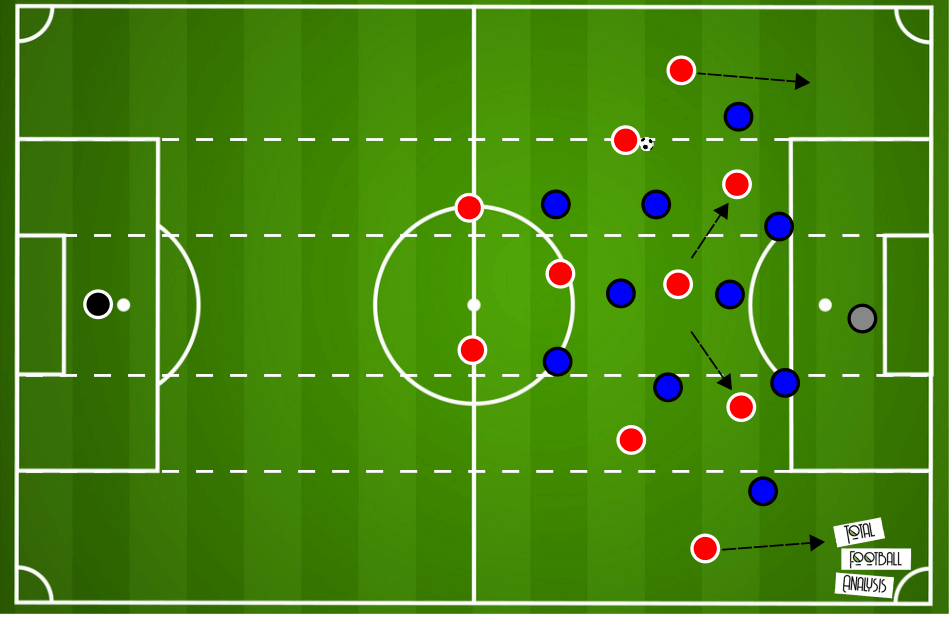
The graphic above shows how with such a setup, the team can still achieve the necessary overloads with the midfielder wide and just behind the full-back and the inverted forward in the half-space.
Defensive style of play
The final part of our tactical analysis of Unai Emery at Villarreal will look at the Spaniard’s preferred defensive systems. Similarly to what was the case in previous sections, we can confidently say his defensive structures rarely change whenever he swaps clubs. Throughout his tenure at Arsenal, Paris Saint-Germain and beyond, Emery was always an advocate of a high pressing system that forces turnovers and aims to win the ball high up the pitch.
And while it’s a risky manoeuvre that has both yielded his teams goals and made them concede them, it’s highly likely he implements those tactics at Villarreal as well. Before dissecting the patterns even further, let’s take a look at the La Liga side’s defensive style of play in the graph you can see below.
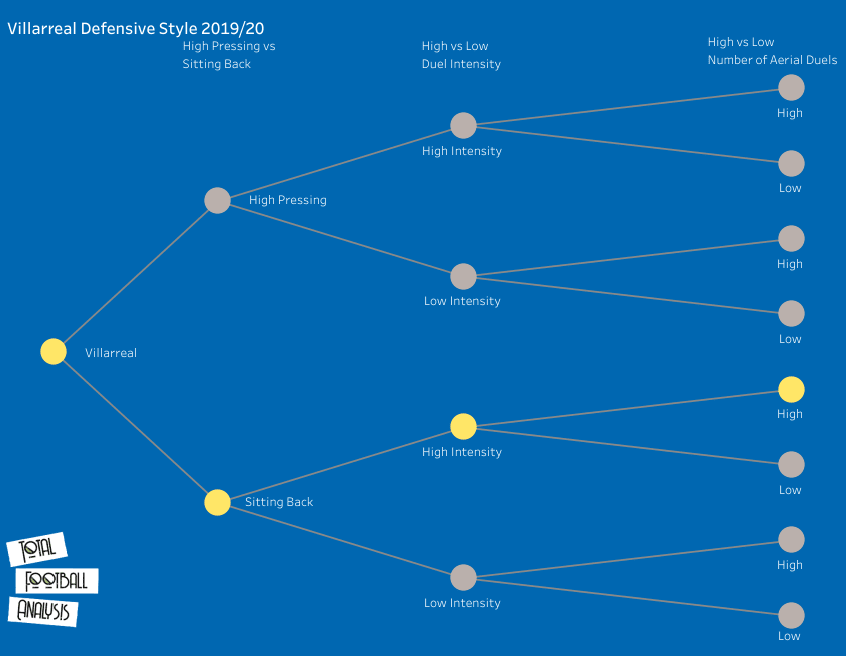
Even though they have been quite resurgent after the break, according to data, Villarreal are still a team that sits back but engages in duels with high intensity. We will explain this shortly. Finally, they tend to force a lot of aerial duels in the defensive phase as well.
But pressing is such a big part of their philosophy and this data may be slightly deceiving. Or so it would seem. Throughout 2019/20, Villarreal have registered 11.76 PPDA (passes allowed per defensive action), the sixth-worst in La Liga, and 5.9 challenge intensity, 13th in the league. This does confirm the findings that can be seen in the graph above. But how is it possible that they are aggressive pressers and yet, their PPDA is among the highest in the league?
Upon further analysis, it becomes clear that Villarreal do press intensely but they don’t do it high up the pitch that often. In fact, their PPDA values have gone up after the break even though it had seemed they were pressing higher and more aggressively than before. The key information here is the location of their press.
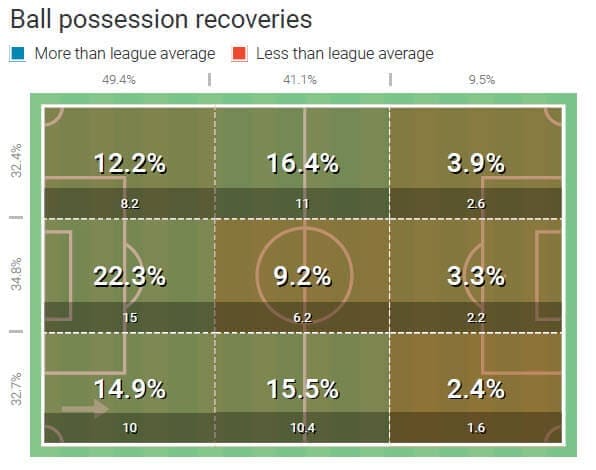
The graph above tells us they mostly press in the first and the middle thirds of the pitch and when it comes to recoveries in the final third, they are among the weakest La Liga sides in that category. Note that the data was collected over their final five games in the domestic campaign. When we go even further and record their total pressures – which are defined as the number of times they applied pressure to opposing player who is receiving, carrying or releasing the ball – they tally only 1,025 in the final third, the second-worst in the league, out of the total of 5,597.
So yes, Villarreal are an aggressive team. Their total number of pressures puts them in seventh place in La Liga. But they are a team that will collapse in the first and the middle thirds rather than always extending that pressure all the way high up the pitch. So how does that exactly align with Emery’s vision of defending?
It doesn’t seem it’s a perfect match but the intensity the coach loves matches the one the team is used to putting out. However, it’s also likely he will push their defensive line higher and turn them into a pressing machine. This, after all, is a trademark of his.
Emery’s squads press in a ball-oriented way and remain in a compact and narrow structure all the way. Once the ball is successfully retained higher up the pitch, the team spreads to counter effectively. And while the formation itself can vary between a 4-4-2, 4-3-3 or even a deeper 4-5-1/ 5-4-1 if the initial press is bypassed, some common features follow Emery into every team: they aggressively push the opposition towards the byline and use it as an additional man and their pressing structures translate well into counter-attacks.
An example of that can be seen below as Arsenal first force Eintracht Frankfurt out wide and then after surrounding them and pushing them against the byline, they make them either go back or attempt a risky pass across the pitch. This ultimately leads to an interception and the Gunners get a great opportunity from their successful defensive structure.
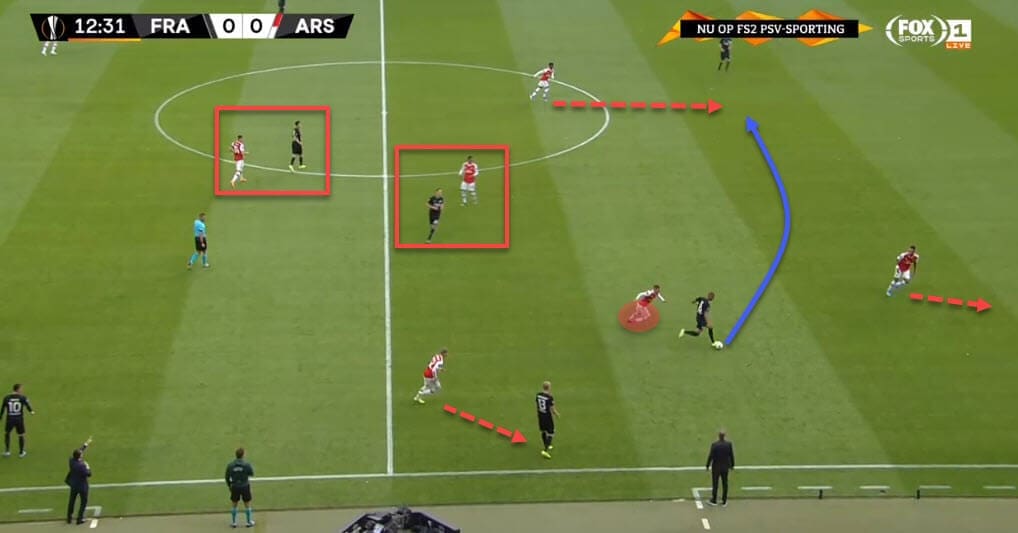
And this is a common feature in Emery’s tactics – aggressively force the opposition into unfavourable areas of the pitch and then collapse until possession is retained. In the final third, they might man-mark their counterparts heavily while in the middle third they form structures that lend themselves to great transitions, often boxing the ball-carrier in.
Another thing you can notice Emery do is completely overload one side of the pitch, achieving numerical superiority when hunting for the ball and squeezing the possession out of the opposition.
A similar thing can be seen below. Notice how there are six Arsenal players essentially overcrowding the whole left flank of the pitch. They end up snatching the ball away and immediately have players in place for a counter.
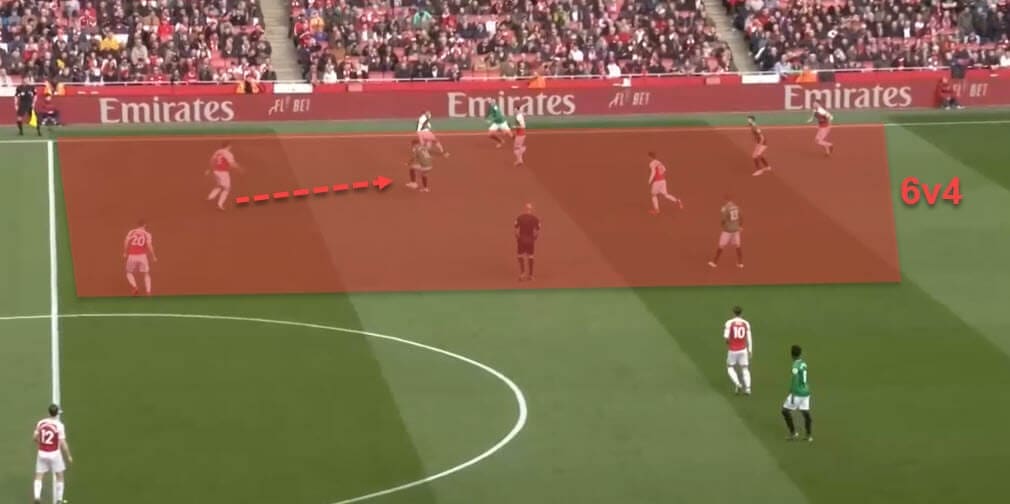
At the end of the day, we can surely expect Emery to continue his insistence on high-pressing and we just may see Villarreal’s backline move up as they squeeze their opposition out of possession.
Of course, this could also make or break the team since holding an extremely high line is an unforgiving task and is something that has burned the Spanish coach in the past.
Final remarks
Villarreal’s appointment of Unai Emery is indeed exciting and while going as far as saying it’s a perfect match would be too much, we will say that the two parties seem to complement each other on paper. From the positional build-up structures to the aggressive pressing when defending, the Yellow Submarine may very well embrace Emery in full.
2020/21 can’t come soon enough.






Comments